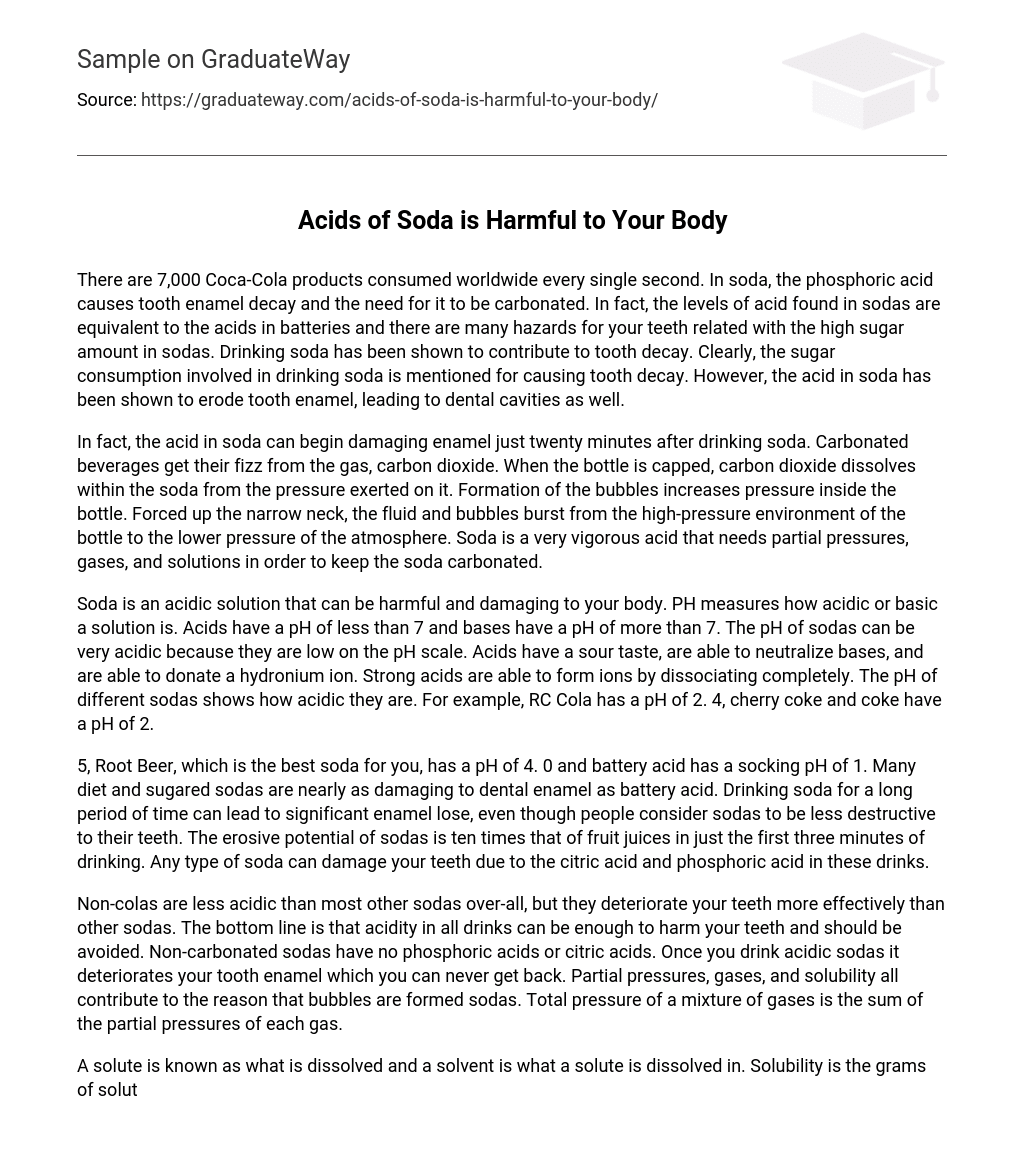There are 7,000 Coca-Cola products consumed worldwide every single second. In soda, the phosphoric acid causes tooth enamel decay and the need for it to be carbonated. In fact, the levels of acid found in sodas are equivalent to the acids in batteries and there are many hazards for your teeth related with the high sugar amount in sodas. Drinking soda has been shown to contribute to tooth decay. Clearly, the sugar consumption involved in drinking soda is mentioned for causing tooth decay. However, the acid in soda has been shown to erode tooth enamel, leading to dental cavities as well.
In fact, the acid in soda can begin damaging enamel just twenty minutes after drinking soda. Carbonated beverages get their fizz from the gas, carbon dioxide. When the bottle is capped, carbon dioxide dissolves within the soda from the pressure exerted on it. Formation of the bubbles increases pressure inside the bottle. Forced up the narrow neck, the fluid and bubbles burst from the high-pressure environment of the bottle to the lower pressure of the atmosphere. Soda is a very vigorous acid that needs partial pressures, gases, and solutions in order to keep the soda carbonated.
Soda is an acidic solution that can be harmful and damaging to your body. PH measures how acidic or basic a solution is. Acids have a pH of less than 7 and bases have a pH of more than 7. The pH of sodas can be very acidic because they are low on the pH scale. Acids have a sour taste, are able to neutralize bases, and are able to donate a hydronium ion. Strong acids are able to form ions by dissociating completely. The pH of different sodas shows how acidic they are. For example, RC Cola has a pH of 2. 4, cherry coke and coke have a pH of 2.
5, Root Beer, which is the best soda for you, has a pH of 4. 0 and battery acid has a socking pH of 1. Many diet and sugared sodas are nearly as damaging to dental enamel as battery acid. Drinking soda for a long period of time can lead to significant enamel lose, even though people consider sodas to be less destructive to their teeth. The erosive potential of sodas is ten times that of fruit juices in just the first three minutes of drinking. Any type of soda can damage your teeth due to the citric acid and phosphoric acid in these drinks.
Non-colas are less acidic than most other sodas over-all, but they deteriorate your teeth more effectively than other sodas. The bottom line is that acidity in all drinks can be enough to harm your teeth and should be avoided. Non-carbonated sodas have no phosphoric acids or citric acids. Once you drink acidic sodas it deteriorates your tooth enamel which you can never get back. Partial pressures, gases, and solubility all contribute to the reason that bubbles are formed sodas. Total pressure of a mixture of gases is the sum of the partial pressures of each gas.
A solute is known as what is dissolved and a solvent is what a solute is dissolved in. Solubility is the grams of solute that can dissolve in 100 grams of solvent at a given temperature. The solubility of gases increases with temperature and surface area including pressure. Gases are explained by the kinetic molecular theory. Molecular collisions cause pressure and a decrease in volume creates an increase in pressure. Properties that affect gases are pressure, volume, and temperature and the number of moles.
When you open the cap of a bottle to the equilibrium inside the bottle is broken and the concentrated carbon dioxide gas exists in the container. The partial pressure of carbon dioxide in the surrounding gas than drops, which forces the concentration of the solute gas to drop, so bubbles then come out. In most liquids there is some dissolved gas but in high surface tension liquids, like water, it makes it tough for bubbles to form. This is because water molecules like to be next to other water molecules, which is known as capillary forces.
To overcome this, a nucleation site, where dissolved gasses form a stream of rising bubbles, is generally needed. Gas molecules come together next to nucleation sites which separates the network of water molecules, when enough are gathered they form a bubble. Capillary forces cause the bubble to initially stay at its nucleation site. The buoyancy of the bubble will eventually cause it to rise as more and more gas molecules assemble in a bubble. Sodas fizz when you open due to the formation of bubbles. Partial pressures, gases, and solutions all enrich the acidity of sodas.
Carbonated beverages, such as sodas, can be very damaging to your teeth and need to be kept at equilibrium and be fizzy. The pH of soda is equivalent to the pH of Vinegar, which is around 2. 5, about the same as vinegar. The acidity of soda takes away tooth enamel because of how acidic the solution is and once you lose your tooth enamel you cannot regain it. When a carbonated beverage, such as soda, is low on the pH scale the solution is be more harmful to your body. Partial pressure is the pressure that a gas in a mixture would apply if it occupied the same volume as the mixture at the same temperature.
When there is an increase in temperature and pressure, the solubility of a gas increases as well as surface area. If the volume of a container is fixed, then increasing the temperature will increase the pressure, and decreasing the temperature will decrease the pressure. This would be the case for a gas in a closed solid container, such as a carbonated soda in a bottle or can. Everything that creates soda has involved chemistry in many ways, including knowing about pH and the pressures that are involved to produce it.





